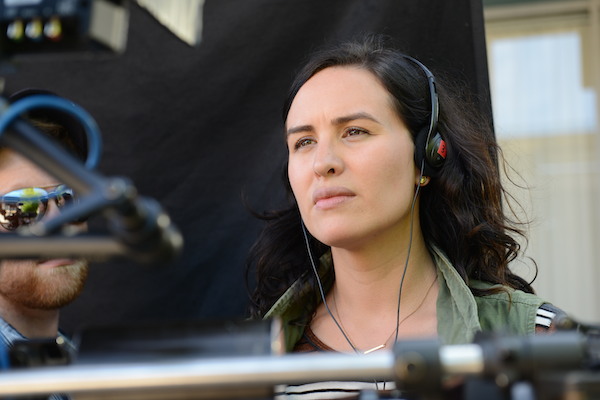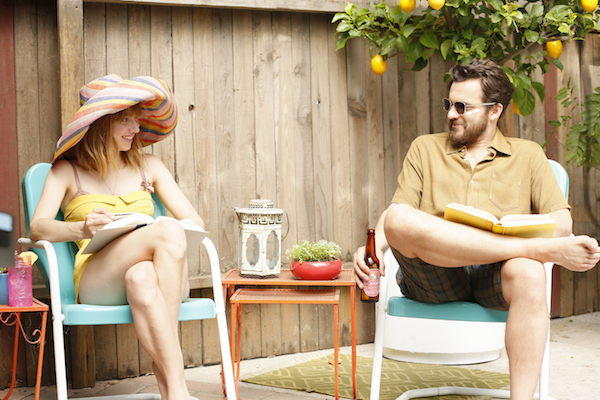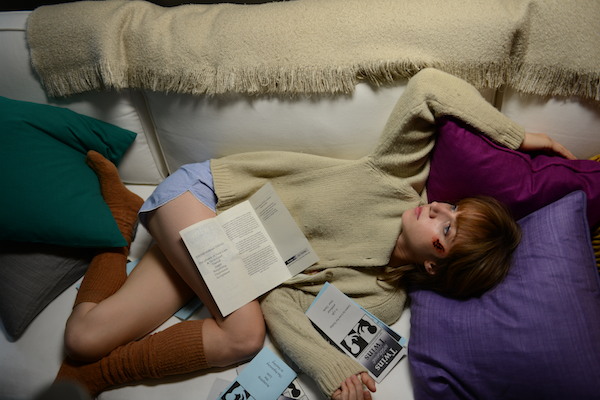The Pretty One is a bittersweet Valentine. It is the feature film debut from director-screenwriter Jenée Lamarque. Zoe Kazan (grand-daughter to Elia Kazan and creator of Ruby Sparks) plays sheltered, developmentally-delayed Laurel. Upon the death of her twin sister, Laurel tries to reinvent herself by assuming her twin sister Audrey’s identity. Jake Johnson (The New Girl) as Basel, the boy next door, exudes a husky warmth reminiscent of a young Walter Matthau. The film features cameos from John Caroll Lynch (Fargo) as Laurel’s widowed father and Ron Livingston (Swingers) as Audrey’s illicit and cheating lover.
The Pretty One was produced by Steven Berger in collaboration with veteran producer Robin Schorr (The Sixth Sense, Jerry Maguire). Berger was Lamarque’s classmate at the American Film Institute, where they collaborated on the 2012 Sundance Film Festival short, Spoonful; Lamarque met Schorr at an AFI-sponsored pitch festival.
The film, The Pretty One, has a singular look and feel that produces an unsettling tone. It rides the wave between loss and love. This budding screenwriter-director tackles some big ideas with poetic flair, leaving me looking forward to coming attractions.
I recently had the pleasure of speaking with Jenée Lamarque about identity, loss, and her own coming of age — as a woman and an artist.

Sophia Stein: How did you discover the subculture of twins who had lost their twins?
Jenée Lamarque: I was writing a screenplay about a twin-less twin, and I found this book. It was a collection of first-hand accounts, one-two page stories of twins who had lost their twins — at birth, as young children, as teenagers, or even later in life as the result of an accident or illness. Each account was so incredibly moving in its own way. It’s such emotionally rich territory, to lose one’s twin is sort of an extreme version of the loss of a loved one.
S2: You have commented that The Pretty One is an extremely personal film. In what ways?
JL: My best friend passed away from complications of cystic fibrosis the week that I graduated from college. That was a really weird time for me. I had no idea what I was doing or where I was going. Laurel does not know where she is headed. She hasn’t really grown up yet, and she is faced with this great loss of her twin.
S2: The Pretty One is your feature directing debut. In 2012, you went to Sundance with your short film, Spoonful. To transition from directing a short to directing a feature takes guts. In what ways were you like Laurel, insecure and scared to take that chance, and in what ways were you like Audrey, bold and brave in the process of making your first feature film?
JL: When you are making your first feature, you are taking a giant leap of faith. I feel that is what Laurel does in the movie. Laurel is pretending to be someone who is more put together than herself, biting into life, and learning how to live. When you are making your first feature, you have to “Fake it til you make it.” [Big laugh.] You just have to dive in headfirst and have faith in the end. I feel like I have come into my own a bit in taking that leap of faith.

Schorr Pictures and Provenance Pictures.
S2: You observe, “Women in general struggle a lot with two questions: ‘Where do you fit in on the spectrum of femininity?’ and ‘Who am I?’” How does your film examine these two questions?
JL: Some of my girlfriends don’t wear any make-up and almost never cut their hair, and some of my friends would never leave the house without a full-face and without presenting themselves in a very composed way. Laurel and Audrey represent both ends of this spectrum. Laurel never cuts her hair, doesn’t wear make-up, and doesn’t buy new clothes, while her sister Audrey makes a purposeful effort to present herself in a conventionally beautiful way. No matter where you land on that spectrum, I think that there is a built-in hierarchy in our culture of what women should look like and be like. I don’t agree with that hierarchy. I think that women should make decisions about how they present themselves in terms of what makes them feel good.
With twins, people are constantly searching out differences, to label who is who. Audrey gets her self-esteem from others, and Laurel gets her lack of self-esteem from others. They each suffer because of this. The story concerns Laurel learning how to make her own assessments and to not internalize judgments of the outside world as truth.
S2: The screenplay made the Black List in 2011. Did that help propel the project in any significant way?
JM: I think that recognition gave us some momentum and credibility in casting. It helped actors to be more excited about the project then they might have otherwise been.
S2: Regarding casting, what was it about Zoe Kazan’s audition that you knew she was the actress to play these twin roles?
JM: More than anything, I think it was a completely intuitive decision. We had been trying to cast our lead for about six months, and no one had clicked or felt quite right. When Zoe came in, I was riveted. Just her physicality was hilarious to me. Her physicality changed drastically from one character to the other, yet felt very natural. We asked each actress to audition for Laurel, Audrey, and then Laurel pretending to be Audrey. I felt like Zoe got the tone of the film. I immediately looked over at my producer, Steven Berger, we locked eyes in this completely unspoken understanding, “There’s our girl!” The role had seemed so difficult to cast, and then she just came into the room! So it was an exciting moment, the kind you always dream of.

Photo courtesy of Schorr Pictures and Provenance Pictures.
S2: I read that the casting of Jake Johnson as Basel, Laurel’s romantic interest, was unusual?
JM: I have very strange dreams. I had just seen Jake in this film Ceremony where he plays Uma Thurman’s brother. He is clearly in love with his sister who is getting married. His character is in crisis, but not addressing it at all, other than drinking really heavily. Jake is really brilliant in the movie – so drunk and so funny! All of that humor comes from this place of real pain. Then I had this dream where Jake was this barista in this coffee shop, and I wanted to offer him the role. In the dream, however, I didn’t know his real name, so I had this other fake name that I called him. The next week, (when I remembered his real name!), I told the casting director, Mary Vernieu, and our producer, “I really think Jake Johnson would be great,” and they immediately agreed. So we offered him the part.
S2: Do your sleeping dreams often influence your artistic process?
JM: I try to meditate and day-dream a lot about artistic decisions. You have to process things, and being awake is not always the greatest way to process these choices.
S2: You studied poetry as an undergraduate, and your film is very poetic. Did you start off as a poet?
JM: I was an English major in creative writing with an emphasis in poetry [at Stanford Univeristy]. My best friend in college (the one who passed away) was a talented writer, and he encouraged me to start writing actually. I found that I had a knack for writing poetry. When I graduated, I didn’t want to pursue a career in poetry. There are a lot of similarities between writing screenplays and writing poetry. As a screenwriter, you’re still creating images on paper.
S2: In shooting The Pretty One, you cast a camera double for scenes where one twin was talking to the other. The actress who plays the double is in one sense the Laurel who never actually gets to come our of her shell or be acknowledged. How did you approach casting the double?
JM: We had to cast someone who had a similar build to Zoe. Katherine Macanufo came in and auditioned, and we went with the person we felt was the best. We asked a lot of Katherine. She had to get her hair cut and colored, which is a very emotional thing for a woman to have to do. You can see Katherine in a couple of the over-the-shoulder shots, but for the most part, she is off-screen. In the split-screen, both characters are played by Zoe. Katherine was in the thick of it in rehearsals with us. She and Zoe were trying to establish a relationship. It really helped Zoe to be able to have someone real to play off of. Katherine she saw it as an opportunity to gain more experience working on film and learning about the technical process. We were lucky to have her. We couldn’t have done it without her.

Schorr Pictures and Provenance Pictures.
S2: The tone of the film is tricky, as you rightfully acknowledge. You say that you were inspired by Harold and Maude, Little Miss Sunshine, and Lars and the Real Girl, in that those films “use humor as a kind of gateway that allows the darkness of their subject matter to enter your heart.” What was your approach in navigating tone?
JM: Tone was mostly a challenge in the writing process. I bit off a lot in choosing to make this film. Zoe and I worked together for quite a while before we started shooting. She came over to my house, and we went through the script very, very, very slowly — over every single line. So we were really on the same page in terms of what we were trying to accomplish when we were on set. Zoe was great in giving us a lot of options in terms of how far we would go with certain comedic moments in filming. We were really lucky to have a week of rehearsals. In rehearsals, we didn’t do anything with the script directly. It was all about creating relationships between the actors and the characters, improvising and creating backstory.
S2: Your film recalled for me a Coen brothers aesthetic, in that the world you have created is so unique unto itself. Have you been inspired by their work?
JM: Absolutely. I remember that I saw Raising Arizona when I was really young in a movie theatre (probably before I really should have been allowed to see it!), and I remember being obsessed with that movie. I love their style. I love the way they establish a tone that is wholly singular to that film. And they have tackled such a variety of tones. They are hilarious and dark.
S2: The “look” of your film is genuinely striking. What was your approach to the production design?
JM: After I had written a few drafts, I realized that there was a strong fairy-tale element to the story. I came across an article that remarked upon how fairy tales always take place in a “Once upon a time” — not in a specific time period. So when I was collaborating with our production designer, Anne Costa, we talked about how we wanted there to be a timeless quality to the film — in the sense that you can never determine exactly what year it is, with a mix of styles and periods. We deliberately chose locations with no modern buildings; our guideline was nothing built after 1980.
My parents are from this dairy town, Chino, where the state prison is. There are lots of cows, and it smells like cow-poop. When I was growing up, on Sundays, we would go on cow rides — go around and see if cows were giving birth. Chino is only about an hour from LA, but when you go there, you feel like you’re in a different era. Laurel is stuck in the past, so that it feels almost as if you are traveling forward a bit in time when she enters into Audrey’s life.
Our costume designer, Emily Batson and I had really been talking about clothes for several years before making the film. We decided on a pale wardrobe palate for Laurel, and then for Audrey, more jewel-tones. When Audrey comes home, she is wearing that deep wine-colored dress and bright red lips. Cinematographer Polly Morgan and I also discussed the visual progression in regards to color. At their childhood home in the beginning, there is a more faded quality. Then when Laurel moves into the city, everything becomes a lot more saturated.
S2: The use of the peonies as a prop in the graveside scene, where Laurel is telling Audrey that she has fallen in love, is so sensual – that contrast between the grave and those saturated flowers.
JM: Peonies were Audrey’s favorite flowers. I don’t think anyone is going to notice it, but the flowers that are dead in Audrey’s apartment when Laurel arrives there are also peonies. That was a detail that we planted. Zoe associated them as her sister’s favorite flowers, so she was touching them in this very tender way.
S2: I love the original music in your film by Julian Wass, and the very cool original songs by Simone White. How did you work with your husband, composer Julian Wass, on the music?
JM: Obviously, Julian knew about the film from the very, very, very, very beginning … because I had been working on it at home. We have been watching movies side by side for years now, so we talk a lot about film music and have very similar tastes. When you have known someone for so long, it becomes really exciting and fun to collaborate. He knows what I like, and I know what his strengths are. My husband produced Simone White’s last record, Silver Silver, and one of the songs is from that record. Simone also covers a song by Frank Bango that we use in our score. Julian’s music creates a spirit that underlies the whole film.
S2: Basel introduces Laurel (who is pretending to be Audrey) to this game, “The Easier to Pretend that We are Married Game.” What was your inspiration for that?
JM: It is so circuitous how you come to things. I had a friend, Maggie Phillips, who had painted this wonderful series of pool paintings called the “Marco-Polo Series,” and I thought that I would use those in the film for Laurel’s paintings. Then I sort of back-tracked with this pool theme. It’s not their pool, it could be the neighbor’s pool. What if their neighbors have this perfect life, and Basel and Laurel want to be just like them. When you are first getting to know someone, it is so exciting to be playful with that person and this is the sort of game that you might play with someone when you are first falling in love.
S2: “Porcupine” is the nickname Laurel’s dad uses for her. Do you have a nickname in your family?
JM: Do you know the French song “Raspberry Beret”? My mother-in-law was making a song up and she was like “Raspberry Jenée.” So my nickname became Raspberry, and now she calls me Razzleberry.
S2: Laurel starts out as an artist in your story by copying work of others, but by the end of the film, she becomes her own thing, carves out an original identity for herself. When did you feel like you really came into your own voice as a filmmaker?
JM: That has been a difficult process. It was definitely over the course of making this film. Even now, I feel like I am constantly figuring out who I am and what is important to me as an artist. I really struggled with that a lot in film school at AFI. First of all, at the time I started film school, I had a six-month old baby.
S2: How did you do it?!
JM: I don’t know. My husband is awesome. He luckily worked from home, so we figured it out. But it was really hard. Motherhood has changed me a lot. I felt like I had spent so much of my life not listening to myself and not valuing myself. I felt like I really owed it to my daughter to figure out who I was and what I wanted … so that she could have that example, so that she could do the same for herself, as a mature woman.
I would meditate before I wrote in film school. It was just a private thing, to calm the critic or monkey-mind, whatever you want to call it. Through that process of needing to write to fulfill my assignments, I figured out how to listen to my own voice. And that’s where I wrote this film – when I was in film school.
Top Image: Zoe Kazan (Laurel, pretending to be Audrey), “The Pretty One.” Photo courtesy of Schorr Pictures and Provenance Pictures.
For more information, “The Pretty One” official website.
